|
Expansion
Although Sir Kenneth, his wife Betty, and John devoted all of their
spare time to assembling the Lumimeters, they could still not keep up
with the demand. Orders were pouring in from many photographic dealers
and it soon became obvious that something had to be done to improve
the situation. John decided to
leave his job at Villiers, to work full time in what was rapidly becoming the
family business.
|
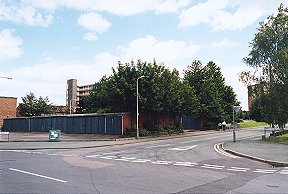
The site of Merridale works
|
More and more orders kept on coming, and even with John
working full time they still could not satisfy the demand. Sir Kenneth
now decided that it was time for him to show more commitment, and leave his job
to work
full time on the project. They also decided to look
for proper premises, and found a small workshop which was available in
the old Merridale Works in Merridale Street. |
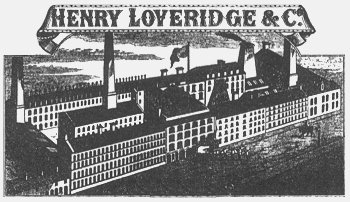 |
A very stylized drawing of Merridale Works that
was taken from an old trade directory. |
Although the floor space
was only about 27ft x 15ft, the rent was quite cheap and so they
decided to take it. The business was formed into a Limited
Company with the two brothers as directors. Sir Kenneth was Managing
Director, John was Technical Director, and Betty was Company
Secretary. They soon started their first two employees who were Mrs Florence Abbiss and Mr
Reg Simmons. K.G. Corfield Ltd was an immediate success. During 1949
they sold 5,000 Lumimeters.

|
With the success of the Lumimeter thoughts
naturally turned to other products. Sir Kenneth had the
inspiration, and many of the ideas for the products that were
to follow, and John had the necessary design skills to make
the products a reality. The first was a hand-held
split image precision rangefinder called the Corfield
Telemeter Rangefinder. It was substantially built around a
die-cast, cream stove enamelled, aluminium case with black
leathercloth panels. The meter was held in place on the user's
hand by a strong elastic strap into which the fingers were
inserted. The two images were aligned by a lever on the
right-hand side which moved a red pointer across a distance
scale. When the two images were aligned the focus setting
could be read from the scale. A very bright image was produced
due to the large size of the rangefinder. Two versions were
available, one with an imperial scale of 3 to 300ft and
another with a metric scale of 1 to 100m. |
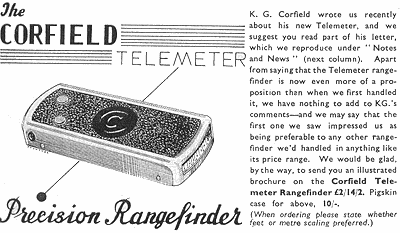 |
A Telemeter advert from 1950. |
The second new product was the Corfield Optical
Exposure Meter. It used a pattern of black circular dots, divided
into two halves of unequal brightness to measure the light level. In
use the film speed was set and the meter was held to the eye. The knob
was rotated until the dots in the darker half of the image
disappeared, and the exposure time was read from a scale. This
technique allowed accurate readings to be taken in extremely low light
levels. The instrument was well built in a die-cast aluminium case
with a black crackle finish.
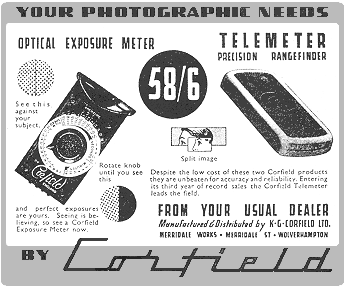 |
A 1951 advert for the new Corfield products |
The Lumimeter was still selling extremely well, but it
required a lot of time and labour in its construction, and so it
was now time for a complete redesign. The new version, the Lumimeter
MK2 was not only easier to manufacture, but was simpler and quicker to
use and looked very professional. It was easier to construct because
it was housed in a one-piece sheet metal body with plastic sides. All
that had to be done to assemble the case was to insert and tighten a
tie rod which held the sides in position.
 |
In use the paper speed was
set by rotating the pointer on the front of the instrument, and the
Lumimeter was moved on the enlarger baseboard until the darkest part
of the negative could be viewed on a photometric spot in the centre of
its screen. The knob was then rotated until the spot disappeared and
the exposure was read from a scale. The exposure scale was from 1 to
240 seconds, and the case was finished in a smooth black
wrinkle finish. |
It was launched in early 1951 and
was an instant success, appealing to both amateurs and professionals
alike. Within the next few years sales reached an incredible 200,000
units.
 |
A 1951 advert for the new Lumimeter |
More darkroom products appeared with the introduction
of the Corfield Masking Frame and the Corfield 5 x 4in Contact
Printer. The masking frame was made of steel and sold for 12s.6d.
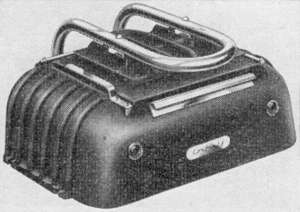 |
The extremely compact 5x4 printer had a solid die-cast aluminium case, and was
indirectly lit by
two 25 or 40 watt lamps for even illumination. Accurate timing of
short exposures was ensured by arranging the lamps to glow
dull red when not printing. A novel feature was that it was possible to
insert shading devices beneath the negative. |
The contact printer was extremely robust and sold for
£4.10s.
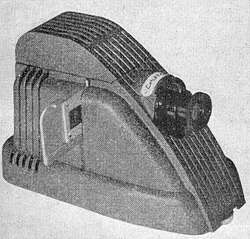 |
The next product, one which had nothing to do with the
darkroom, appeared in 1952. It was the Corfield 2 x 2 Slide Projector.
The slim
die-cast body was finished in grey crinkled enamel, and illumination was
provided by a 250 or 300 watt lamp. Ventilation slots were
incorporated in the top and a Chance O.N.20 heat filter was
positioned behind the slide. The f3.7 four element lens had a
focal length of three and three quarter inches and was of excellent
quality. |
The selling price was £14.18s.6d for the 250 watt
version and £15.3s.6d for the 300 watt version. Sadly it got rather hot after about half an hour, and didn't
sell very well. After a little while it was discontinued.
Corfields also became distributors for a range of
European photographic equipment including Stag timers, Omnica carrying
cases, Exakta cameras and Leidox cameras. Their wide product range can be seen from the
following entry in
the Wolverhampton Classified Industrial Directory of 1952:
K. G. Corfield Ltd
Merridale Works
Merridale Street
Wolverhampton
Telephone: Wolverhampton
25815
Products: Telemeter precision
rangefinders, enlarging exposure meters, all-metal masking frames for
enlargers, optical exposure meter for the camera, contact printing
equipment, photographic accessories, low-level illumination
photometers for light measurements in interiors, apparatus for applied
photometry, industrial applications of photocells (magic eye) to
colour tests and counting etc.
This product range was certainly impressive, but more
was yet to come!
 |
|

|
|
 |
|
Back |
|
Return
to the beginning
|
|
Continue |
|































